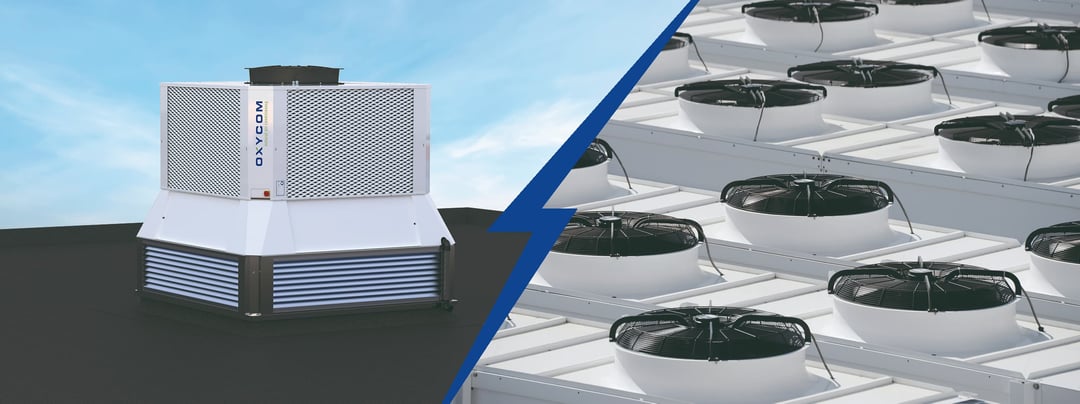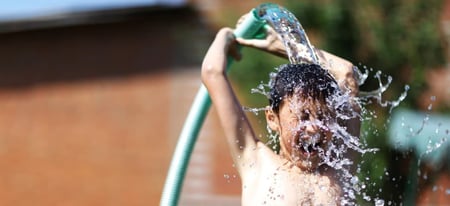
Evaporative cooling vs air conditioning
Evaporative cooling provides a highly effective and environmentally responsible indoor climate solution for the industry. Yet many people are still suspicious of its cooling efficiency and instead stick to what they know: conventional air conditioning. This is unfortunate, as conventional air conditioning leaves a massive carbon footprint - especially in comparison with two-stage evaporative cooling.
This page provides a clear comparison between evaporative cooling and air conditioning - find out what advantages work best for you.
N.B.: This page refers to evaporative cooling and two-stage evaporative cooling. Two-stage evaporative cooling employs an improved adiabatic technique with higher efficiencies, lower supply temperatures and reduced humidity. The air conditioning we refer to is mechanical cooling used to remove heat and control for humidity through vapour compression.
Fresh, clean air vs recirculated air
Evaporative cooling
Two-stage evaporative cooling uses fresh air to cool and ventilate multiple times an hour. This air is filtered to remove any dust or allergens.
Airconditioning
Air conditioning generally cools recirculated indoor air to avoid extra energy use needed to cool and dehumidify incoming outdoor air.

Energy savings vs energy-wasting
Evaporative cooling
Two-stage evaporative cooling uses only 10% of energy compared to conventional air conditioning. 95% of the cooling capacity is provided through the natural process of water evaporation. The motor-driven fan that regulates the adiabatic process requires 1 kWh of electricity and provides up to 40 kW of cooling power.
Airconditioning
Air conditioning uses 90% more energy to cool and ventilate than evaporative cooling. The cooling power derives from vapour compression in a closed system rather than simply evaporating water. In a further comparison, mechanical cooling systems require 1 kWh of electricity to produce only 2 to 4 kW of cooling power.

Energy-efficiency cooling vs power-surging cooling
Evaporative cooling
On hot days the cooling efficiency of the two-stage evaporative cooling system increases. Warmer temperatures allow for more moisture in the air, and thus the system can evaporate more water. And the more water is evaporated, the more cooling power the system can provide without increasing its energy consumption.
Airconditioning
The hotter the outside temperatures, the more energy is needed for conventional air conditioners to achieve the desired indoor temperature. With the global temperature increase, the window for conventional air conditioning to function energy-efficiently is becoming smaller.
Optimal air humidity vs dry indoor air
Evaporative cooling
Direct evaporative cooling systems can add too much moisture to the air when cooling down to the desired temperature. Two-stage evaporative cooling will provide up to 70% less humidity. In a room, this will result in a humidity level between 40% and 60%. This humidity level helps us fend off viruses and provides comfort against dry eyes and an itchy throat.
Airconditioning
Air conditioning dehumidifies the air. Deep cooling causes the moisture in the air to condense on the cold evaporator. The cooled air then contains less moisture. Comfortable in terms of temperature and humidity, but not always healthy. Our immune system cannot defend itself against viruses in dry air while the pathogens thrive. In addition, dry air can also cause discomforts such as an itchy throat or irritated eyes.
Keeping the city cool vs urban heating
Evaporative cooling
The world’s cities are heating up at twice the global average rate due to rapid urbanization and the urban heat island effect. Evaporative cooling releases process air at low temperatures, thus having a positive impact on the growing problem of “urban heating”.
Airconditioning
By 2100, many cities across the world could've warmed up as much as 4°C if GHG emissions (CO2) continue at high levels. Air conditioners, additionally, release high temperatures from their condenser, negatively impacting the build-up of urban heating.
Water vs other refrigerants
Evaporative cooling
Evaporative cooling uses nature’s most potent refrigerant as its cooling agent - water! With an exceptionally high latent heat of vaporisation (2501 kJ/kg at 0 °C), evaporating 1 m3/h water generates as much as 695 kW of cooling power. The evaporated water will finally end up in the air and at a later stage come down as rain. Traditional air conditioning technology would demand at least 250 kW to deliver the same cooling power.
Airconditioning
Nowadays, air conditioning uses "less" damaging chlorine-free refrigerants like hydrofluorocarbons as its cooling agents. These refrigerants are continuously evaporated and condensed in a closed system to achieve the desired cooling. This process needs up to 90% more energy than a two-stage evaporative cooling system. Also, regular refill has to be taken into account to avoid reduced efficiency, as some of the refrigerants will escape into the open air. It should not be forgotten that water is also required to generate electricity. Most of the electricity is produced by power plants using oil or coal and at least 10 liters of freshwater per kWh is needed for steam to run the turbines.

Extremely dry vs extremely humid
Evaporative cooling
Evaporative cooling is a physical process based on water evaporation, meaning that relative humidity affects the effectiveness of the chosen system. The hotter and dryer a climate is, the higher the performance of an evaporative cooling system. In a tropical climate, though, the system might be less efficient in cooling. However, indirect/direct evaporative cooling systems hold their performance far better than direct systems in more humid regions, such as coastal areas, during humid hours.
Airconditioning
Air conditioning allows for comfort in all climates. In terms of relative humidity, AC systems are not affected in their efficiency. However, the higher the outside temperatures, the more energy is needed to provide the required cooling capacity.
The trade-off here is whether to spend 90% more energy on even cooling all year round (AC) or to save up on 90% energy and experience slightly less efficient cooling, only a couple of hours a year (evaporative cooling).
.jpg?width=800&name=Infranorm%20(2).jpg)
Minimize your carbon footprint!
If your mission is to work towards a zero-emission world & you want to provide your employees with a healthy and comfortable environment, then evaporative cooling certainly is thé way forward. Check out our product page for more information on the possibilities for sustainable industrial cooling.
Related articles
See all articles/Case%20studies%20(Pictures)/Extra/What%20is%20evaporative%20cooling.jpg?width=450&name=What%20is%20evaporative%20cooling.jpg)
Is evaporative cooling as good as air conditioning?
In this blog, we answer whether evaporative cooling is as good as air conditioning. What are the pros and cons of both technologies?

Eight concerns about adiabatic cooling resolved
In this blog, we have listed and resolved eight of the most prevalent concerns, or better yet, misconceptions, about adiabatic cooling.

Water as a refrigerant
In this blog, we explain why water is an excellent alternative to the ozone-depleting R-22 refrigerant in conventional air conditioning and how water-based cooling works.
Back to overview:
Evaporative cooling